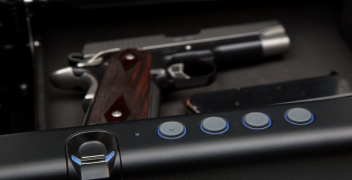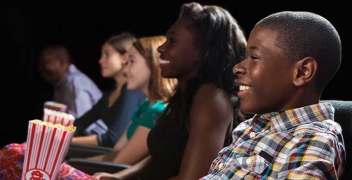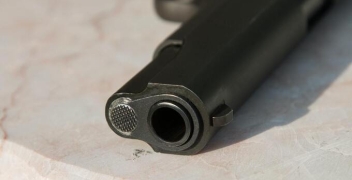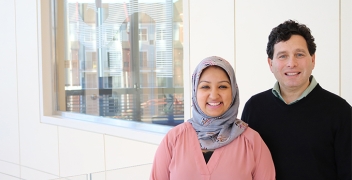Counseling on Gun Safety in the Home
According to research published in the American Journal of Public Health up to one-third of U.S. homes with children under age 18 report having a firearm, making gun safety in the home an important topic for every family. In a world where children will likely be exposed to guns, families need to know how to keep children safe from harm. It's therefore important that healthcare professionals offer counseling about why and how to prevent children from accessing guns.
Gun violence can be a complex and polarizing public health issue in the U.S., however safe firearm storage is an area of common ground. This why the most productive conversations are those that avoid potentially sensitive subjects such as gun rights and legislative control, and focus instead on the goals we share with patients and families: the health and safety of children.
Helpful Information to Guide the Conversation
- Why Guns in the Home Are a Risk For Children
If children have the access and means to a gun, they are at risk for acting on natural curiosity or a momentary impulse and harming themselves or someone else.
Research tells us that one half of all U.S. gun owners keep their guns loaded at least some of the time and that 40 percent of gun owners store guns in a bedroom or closet, NOT in a locked case, cabinet, or vault. Most adolescent suicides occur in the home and the firearm is owned by a parent. Additionally, many of these suicides are impulsive with a time of idea-to-action of less than 5 minutes. In youth suicides, the use of a firearm results in fatality in 90 percent of attempts. This is a much higher rate than the use of other means such as drugs or cutting. Note that 90 percent of those that survive an attempt do not ultimately die from suicide, so if youth are prevented from accessing a gun in a moment of crisis, they almost always survive to get the mental health support they need. Read more about youth suicide and self-harm.
Younger children are also at risk of accessing a gun. Seventy-five percent of 5-14 year olds know where the guns are kept in the home – even if the parent thinks they don’t.
Despite pervasive misperceptions, there are no laws against health care providers asking about guns in the home or providing guidance about gun safety.
- Counsel at Developmental Milestones
Safety is our wheelhouse as pediatricians, and health care providers play an important role in educating families about all areas of injury prevention. Ideally, gun safety should be addressed at multiple touch points during childhood, and when certain extra risks become evident.
Birth – Ask about guns in the home in the context of home safety recommendations that are routinely offered at all newborn visits, such as the importance of smoke detectors and car seats.
Toddler (12-24 months) – Children are developing motor skills rapidly and love to walk and explore. They also love to problem solve. Therefore, figuring out how parts of a gun move can be as interesting to them as opening cabinets and drawers. However, they do not understand concept of danger and often ignore “no” or quickly forget.
Preschool/Young School Age – At this age, children have good motor development but lack probability judgment about the consequences of actions (if-then). They are curious and can find everything in their home. This is also the age that children tend to play at other people’s homes. Helping families feel comfortable asking about firearms in other places children spend time can go a long way to ensuring their safety.
Older School Age – These children are concrete thinkers but still don’t consider cause and effect very well. At this age, they are often not as closely supervised and are developing more independence. Exposure to violence in the media often increases, which can make them even more curious about guns.
Adolescence – Risk-taking increases as adolescents often underestimate the danger to themselves and others, and are further exploring their independence. They are more likely to experience peer pressure and may not want to show fear. In some cases, they may perceive peers to be carrying guns. Due to natural physiologic changes, they can also have mood swings and act impulsively, they are more prone to settling disputes with violence, and some may tragically consider suicide as a solution to challenging situations.
- Counsel If Certain Risk Factors Are Present
When any of these risk factors are identified in a child’s home or life, it’s time to counsel again about gun safety:
- ADHD
- Family violence
- Depression
- Suicide ideation
- Drug alcohol/drug abuse
- Bullying
- How To Frame the Conversation For Parents
It’s not possible to “gun proof” children due to many factors including the cognitive immaturity in younger kids and the perception of invulnerability in adolescents. Parents and caregivers should be encouraged to consider firearm safety within anticipatory guidance about other dangers in home, such as cigarette smoke, stairs, electric sockets, hot stoves, etc. The conversation should be approached free of judgment, with the facts, and with confidentiality assured.
Counsel parents early and often. If they answer “yes” to having a gun in the home, be prepared to use a harm reduction approach. If removing the firearm is not an acceptable option, advise that all guns should be stored unloaded and locked, with no access to keys, and ideally in a gun safe. Explain the importance of locking all ammunition in a separate location.
- How Parents Can Safely Ask About Guns In Others’ Homes
This can feel to some families like an awkward conversation, but it is an important one for us to help families have as their children get older and visit other homes. We can help families have non-judgmental, normalizing conversations by asking about guns in the context of other safety issues such as food allergies, pools and car seats. Parents can say it’s really about their child: “I have to be extra careful because my son/daughter gets into everything!”
Click here to view a CHOP fact sheet on gun safety tips created by experts at CHOP.
Recommended Resources
Watch this webinar for health care providers about Counseling Families About Gun Safety in the Home:









